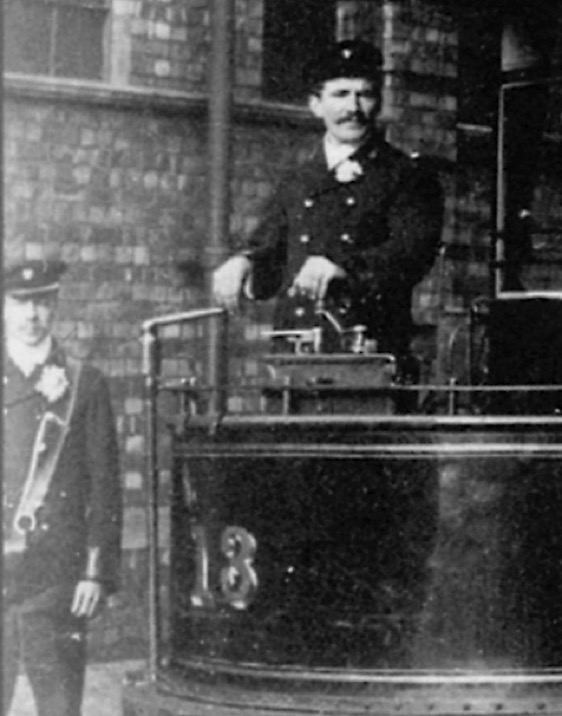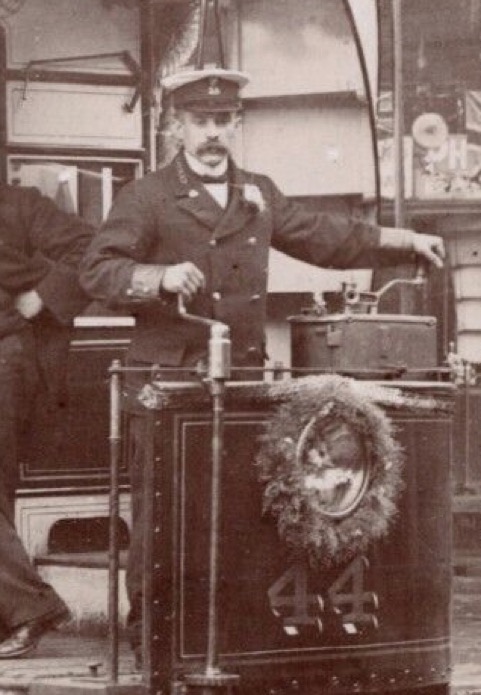Oldham, Ashton and Hyde Electric Tramways
History
The Oldham, Ashton and Hyde tramway system was owned and operated by the Oldham, Ashton-under-Lyne and Hyde Electric Tramways Co Ltd, which was a subsidiary of the much larger British Electric Traction Company Ltd (BETCo); the BETCo was a concern which at its zenith, either owned, part-owned or leased around 50 tramway concerns across the British Isles.
In the late 1890s, the BETCo was aggressively purchasing horse and steam-operated tramways across the British Isles with the intention of converting them to electric traction, as well as promoting schemes for completely new electric tramways. In 1897, the BETCo registered the OA&HETCo to build and operate a standard-gauge electric tramway running from Hathershaw in the north, through Ashton-under-Lyne and Denton, to Hyde in the south. The route essentially followed that of an earlier tramway — promoted by the Oldham, Ashton and Hyde Tramway Co Ltd — which was intended to be steam worked, but which never got further than constructing a small amount of track in Ashton in 1891/2.
The new electric tramway opened on the 12th June 1899, and was an immediate success, regularly returning impressive dividends to its shareholders, and even paying adequate sums into the reserve fund.
Three years later, a link was made — in Ashton Market Square — between the OA&HETCo's tracks and those of the nascent Ashton-under-Lyne Corporation Tramways, the first lines of the latter system opening for business on the 16th August 1902. A further tramway connection was made at the southern end of the system with a new line built by Hyde Corporation between the OA&HETCo's terminus at Gee Cross and those of Stockport Corporation Tramways at Pole Bank. The new line was leased to the OA&HETCo for 15 years, with the company having running rights over SCT metals to Stockport, and the SCT having running rights through to Hyde.
Yet another tramway concern opened in the area on the 15th October 1903 — the Stalybridge, Hyde, Mossley and Dukinfield Tramways and Electricity Board — which was jointly owned by the councils in its title. This met the OA&HETCo's tracks at Newton Street in Hyde, and a running agreement was reached which enabled SHMD Joint Board trams to reach the centre of Hyde.
The system settled down to a very profitable existence, the only cloud on the horizon being the various councils' right to purchase the enterprise within their respective boundaries after 21 years (from the original tramway order of 1896), i.e., in 1917. This proved to be a major disincentive to investment, the company being reluctant to improve the track and rolling stock in the absence of an extension to its tenure, something the councils refused to countenance. The gradual run down of the system was further exacerbated by the Great War, during which maintenance was kept to the bare minimum, whilst overloading was often severe. Although the councils were granted an extension to the time they had to serve notice on the company — due to the wartime conditions — they eventually did so in September 1918. There was inevitably much disagreement over the state of the system, and therefore its value, but in the end, a formal agreement was finalised on the 24th May 1921. The company continued to operate services until the 1st of July; thereafter, the ACT took over the services within its municipal boundary, as well as those in Waterloo and Limehurst Urban District Councils (3.31 miles); the SHMD Joint Board took over services within Hyde (2.63 miles); whilst Manchester Corporation Tramways took over the services within the boundaries of Denton (1.29 miles) and Audenshaw (0.83 miles) Urban District Councils.
The last ever tram over former OA&HETCo's tracks (Denton to Hyde) was operated by Manchester Corporation Tramways on the 30th December 1947.
Uniforms
Early photos, i.e., those taken around the turn of the century, reveal that motormen wore double-breasted jackets with five pairs of buttons (of the standard BETCo pattern — see link), three pockets and lapels; the collars probably bore embroidered ’O A & H E T’ initials, though these cannot be made out with absolute certainty on the surviving photographs. Conductors wore single-breasted jackets with five buttons and stand-up collars; the latter appear to have carried the same embroidered lettering as the motormen's jackets. The earliest caps were in a kepi-style with a stiff, horizontal glossy peak, and appear to have carried embroidered ’O A & H E T’ initials, probably on a hat band.
From the early-Edwardian era onwards, photos clearly show staff wearing the familiar and largely regulation BETCo uniform. Although this varied somewhat between BETCo systems, as well as across the decades, the cap badges, collar designations and buttons invariably followed a standard pattern. Tramcar crews (both motormen and conductors) now wore double-breasted jackets, with five pairs of buttons, and lapels; the collars carried individual embroidered initials (again probably ’O A & H E T’) on the bearer's left- and right-hand side. The early kepi-style caps were soon changed to a soft-topped type, which were in turn quickly superseded by tensioned-crown peaked caps; the two latter types of cap bore the standard brass BETCo ‘Magnet & Wheel’ badge, which was worn above an employee number.
At some point, probably in the mid-Edwardian era, the double-breasted style of jacket was superseded — for conductors — by a single-breasted design with five buttons and stand-up collars, the latter carrying individual letters on the left-hand side (‘O A & H E T’) and an employee number on the right-hand side, both in brass. At the same time, motormen appear to have been issued with double-breasted, lancer-style tunics with five pairs of buttons (narrowing from top to bottom) and stand-up collars; the latter almost certainly carried the same insignia as the conductors' jackets.
Tramcar crews were also provided with double-breasted greatcoats bearing five pairs of buttons and high, fold-over collars; the latter initially bore insignia of some description, though this cannot be made out with any degree of certainty on surviving photographs. In later years, the collars were often left plain.
Inspectors were issued with single-breasted jackets with hidden buttons (or more likely a hook and eye affair), edged in a finer material than the main body of the garment, and with stand-up collars; the latter would almost certainly have carried the designation 'Inspector' in embroidered script-lettering. In the early years, and possibly right through to 1921 when the system was divided up amongst the local councils, inspectors wore drooping-peak caps; these bore a standard BETCo 'Magnet & Wheel' cap badge, along with the bearer's grade — 'Inspector' — in embroidered script-lettering (photographic evidence for this is, however, currently lacking).
In common with many tramway systems, female staff were employed during the Great War to replace men lost to military service. These ladies were issued with long skirts and single-breasted tailored jackets with five buttons, a waist belt (with button fastening) and lapels; the collars do not appear to have borne any insignia. Wide-brimmed bonnets were also issued — these had a hat band that bore the standard BETCo ‘Magnet & Wheel’ cap badge.
Further reading
For a history of the OA&HET, see: 'A History of Public Transport in Ashton-under-Lyne' by W G S Hyde; Manchester Transport Museum Society (1980).
Images
Motormen and conductors
A poor quality but early staff photo taken at Denton depot, probably around the time of opening, i.e., 1899. The individuals in double-breasted jackets are probably motormen, whilst those in single-breasted jackets are conductors; both grades have kepi-style caps. Some men are without uniforms, suggesting that the initial supplies were either insufficient or constrained; this is also borne out by other early photographs, which clearly show trams in service crewed by staff in informal attire. Image in the public domain.
A conductor and a motorman pose with a pristine Tramcar No 7 — photo undated, but very probably taken in 1899 or 1900 as the vehicle still has trailer couplings, which were later removed. Photo courtesy of Tameside Local Studies & Archives (see link).
An enlargement of the above photograph showing the motorman and the conductor. Both men are wearing kepi-style caps, but there is no sign of the standard BETCo 'Magnet and Wheel' cap badge. The large round objects on their lapels appear to be rosettes, so presumably the photo was taken to mark some now long-forgotten special occasion.
Tramcar No 13 stands in the depot yard at Denton Road, Audenshaw — photo undated, but as the car still has trailer couplings, the photo must have been taken before these were removed (circa 1903). Photo courtesy of the Tramways and Light Railway Society, with thanks to David Voice.
An enlargement of the above photograph showing the conductor and the motorman, neither of whom appears to be wearing an employee number on his cap. Both men are wearing rosettes similar to those seen in the first photo above.
An evocative studio portrait in ‘Carte de Visite’ format of Employee No 107. The card was produced by ’S Searle, Market Street, Hyde, Cheshire’, and although undated, was probably taken in the early-Edwardian era. The embroidered collar initials can just about be made out, with the standard BETCo 'Magnet and Wheel' cap badge and employee number clearly seen. Author's Collection.
Standard British Electric Traction Company Limited ‘Magnet & Wheel’ cap badge — brass. Author's Collection.
The crew of Tramcar No 44, which is resplendent in bunting and garlands, possibly to commemorate the coronation of King Edward VII in August 1902. The vehicle, which appears to be in excellent condition, was built in June 1902.
An enlargement of the above photograph showing the conductor. He is Employee No 107, the man pictured above in the studio portrait.
Another enlargement of the above photograph, this time showing the motorman.
An unidentified single-decker with crew — photo undated, but probably early Edwardian. The caps now appear to have tensioned crowns (tops). Source unknown.
Tramcar No 39, ex-Leeds City Tramways, stands inside the depot on a special occasion — photo undated, but as No 39 was only rebuilt into this form in mid-1902, probably taken not long afterwards. Source unknown.
Tramcar No 23 and crew — photo undated, but probably taken in the mid-Edwardian era. Both men are wearing double-breasted greatcoats and tensioned-crown peaked caps.
A motorman at the controls of Tramcar No 15 — photo undated, but likely to have been taken late in the tramway's life. The motorman's greatcoat does not bear any insignia.
Senior staff
An enlargement of the 1899 Denton Road depot photograph above showing an inspector (right). He is wearing a single-breasted jacket with stand-up collars, hook and eye fastenings, and a drooping-peak cap.
An enlargement of the depot shot of Tramcar No 39 above showing an inspector (second from the right). He is wearing typical 'tramway inspector' garb, along with a drooping-peak cap; the latter appears to bear a standard BETCo 'Magnet & Wheel' badge.
Female staff
A motorman and a conductress pose with an unidentified tramcar in Market Square, Ashton — photo undated, but almost certainly taken during the Great War. With thanks to John Holme of the Manchester Transport Museum Society.